Hubert Cecotti
Quantifying Spatial Domain Explanations in BCI using Earth Mover's Distance
May 02, 2024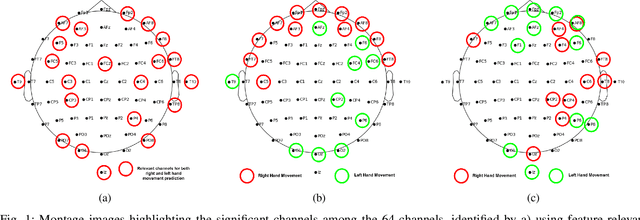



Abstract:Brain-computer interface (BCI) systems facilitate unique communication between humans and computers, benefiting severely disabled individuals. Despite decades of research, BCIs are not fully integrated into clinical and commercial settings. It's crucial to assess and explain BCI performance, offering clear explanations for potential users to avoid frustration when it doesn't work as expected. This work investigates the efficacy of different deep learning and Riemannian geometry-based classification models in the context of motor imagery (MI) based BCI using electroencephalography (EEG). We then propose an optimal transport theory-based approach using earth mover's distance (EMD) to quantify the comparison of the feature relevance map with the domain knowledge of neuroscience. For this, we utilized explainable AI (XAI) techniques for generating feature relevance in the spatial domain to identify important channels for model outcomes. Three state-of-the-art models are implemented - 1) Riemannian geometry-based classifier, 2) EEGNet, and 3) EEG Conformer, and the observed trend in the model's accuracy across different architectures on the dataset correlates with the proposed feature relevance metrics. The models with diverse architectures perform significantly better when trained on channels relevant to motor imagery than data-driven channel selection. This work focuses attention on the necessity for interpretability and incorporating metrics beyond accuracy, underscores the value of combining domain knowledge and quantifying model interpretations with data-driven approaches in creating reliable and robust Brain-Computer Interfaces (BCIs).
Explainable artificial intelligence approaches for brain-computer interfaces: a review and design space
Dec 20, 2023Abstract:This review paper provides an integrated perspective of Explainable Artificial Intelligence techniques applied to Brain-Computer Interfaces. BCIs use predictive models to interpret brain signals for various high-stake applications. However, achieving explainability in these complex models is challenging as it compromises accuracy. The field of XAI has emerged to address the need for explainability across various stakeholders, but there is a lack of an integrated perspective in XAI for BCI (XAI4BCI) literature. It is necessary to differentiate key concepts like explainability, interpretability, and understanding in this context and formulate a comprehensive framework. To understand the need of XAI for BCI, we pose six key research questions for a systematic review and meta-analysis, encompassing its purposes, applications, usability, and technical feasibility. We employ the PRISMA methodology -- preferred reporting items for systematic reviews and meta-analyses to review (n=1246) and analyze (n=84) studies published in 2015 and onwards for key insights. The results highlight that current research primarily focuses on interpretability for developers and researchers, aiming to justify outcomes and enhance model performance. We discuss the unique approaches, advantages, and limitations of XAI4BCI from the literature. We draw insights from philosophy, psychology, and social sciences. We propose a design space for XAI4BCI, considering the evolving need to visualize and investigate predictive model outcomes customised for various stakeholders in the BCI development and deployment lifecycle. This paper is the first to focus solely on reviewing XAI4BCI research articles. This systematic review and meta-analysis findings with the proposed design space prompt important discussions on establishing standards for BCI explanations, highlighting current limitations, and guiding the future of XAI in BCI.
SymNet: Symmetrical Filters in Convolutional Neural Networks
Jun 10, 2019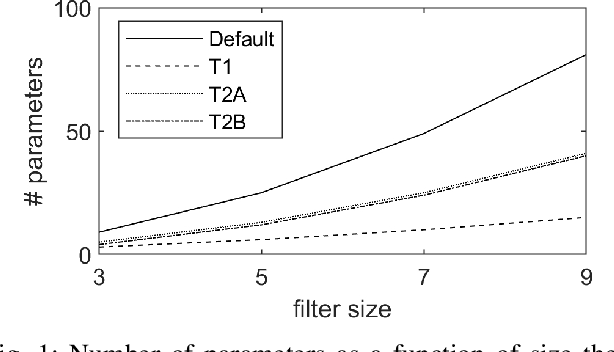

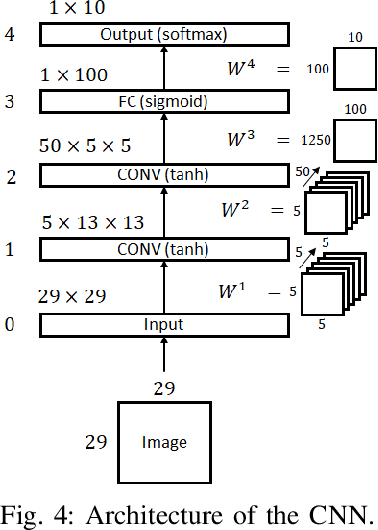

Abstract:Symmetry is present in nature and science. In image processing, kernels for spatial filtering possess some symmetry (e.g. Sobel operators, Gaussian, Laplacian). Convolutional layers in artificial feed-forward neural networks have typically considered the kernel weights without any constraint. In this paper, we propose to investigate the impact of a symmetry constraint in convolutional layers for image classification tasks, taking our inspiration from the processes involved in the primary visual cortex and common image processing techniques. The goal is to assess the extent to which it is possible to enforce symmetrical constraints on the filters throughout the training process of a convolutional neural network (CNN) by modifying the weight update preformed during the backpropagation algorithm and to evaluate the change in performance. The main hypothesis of this paper is that the symmetrical constraint reduces the number of free parameters in the network, and it is able to achieve near identical performance to the modern methodology of training. In particular, we address the following cases: x/y-axis symmetry, point reflection, and anti-point reflection. The performance has been evaluated on four databases of images. The results support the conclusion that while random weights offer more freedom to the model, the symmetry constraint provides a similar level of performance while decreasing substantially the number of free parameters in the model. Such an approach can be valuable in phase-sensitive applications that require a linear phase property throughout the feature extraction process.
Rotation Invariant Descriptors for Galaxy Morphological Classification
Dec 11, 2018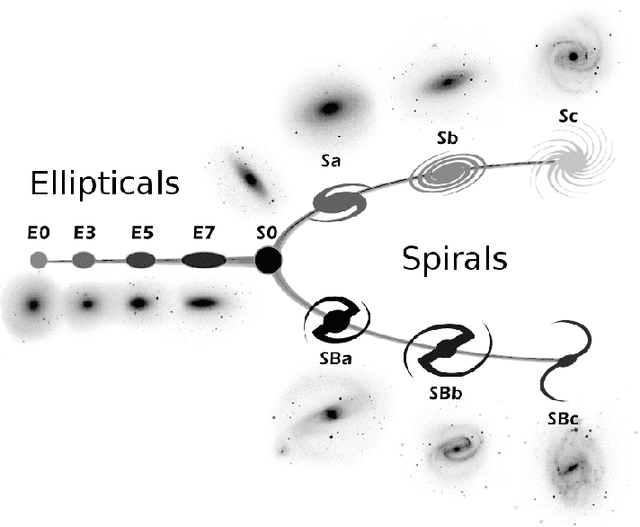


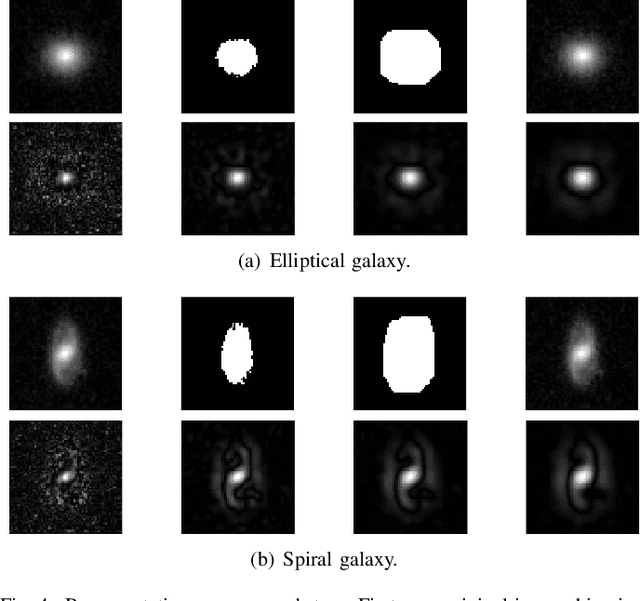
Abstract:The detection of objects that are multi-oriented is a difficult pattern recognition problem. In this paper, we propose to evaluate the performance of different families of descriptors for the classification of galaxy morphologies. We investigate the performance of the Hu moments, Flusser moments, Zernike moments, Fourier-Mellin moments, and ring projection techniques based on 1D moment and the Fourier transform. We consider two main datasets for the performance evaluation. The first dataset is an artificial dataset based on representative templates from 11 types of galaxies, which are evaluated with different transformations (noise, smoothing), alone or combined. The evaluation is based on image retrieval performance to estimate the robustness of the rotation invariant descriptors with this type of images. The second dataset is composed of real images extracted from the Galaxy Zoo 2 project. The binary classification of elliptical and spiral galaxies is achieved with pre-processing steps including morphological filtering and a Laplacian pyramid. For the binary classification, we compare the different set of features with Support Vector Machines (SVM), Extreme Learning Machine, and different types of linear discriminant analysis techniques. The results support the conclusion that the proposed framework for the binary classification of elliptical and spiral galaxies provides an area under the ROC curve reaching 99.54%, proving the robustness of the approach for helping astronomers to study galaxies.
Covariate Shift Estimation based Adaptive Ensemble Learning for Handling Non-Stationarity in Motor Imagery related EEG-based Brain-Computer Interface
May 02, 2018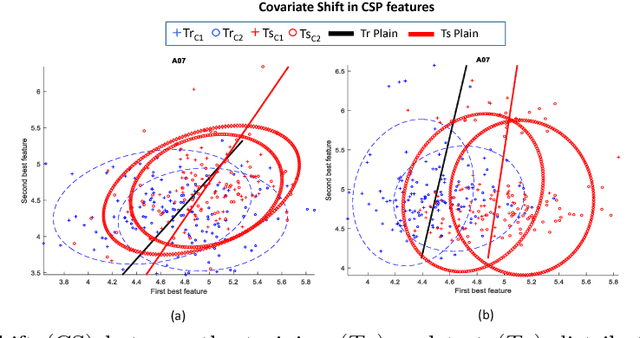
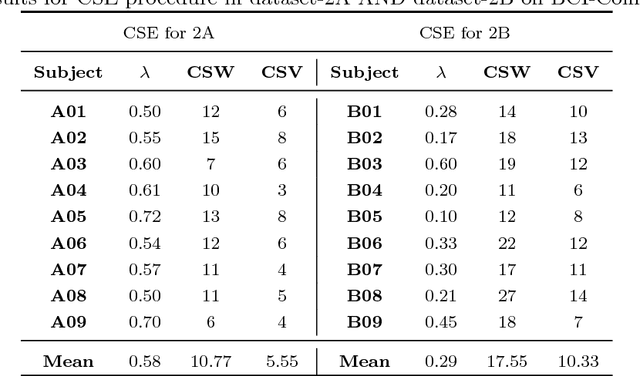
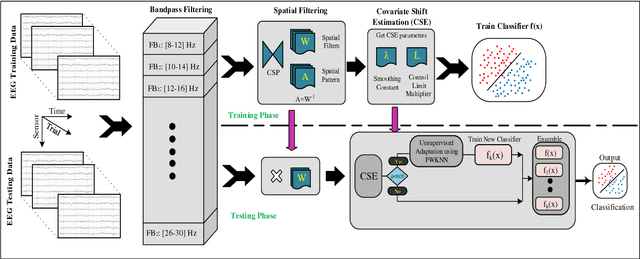
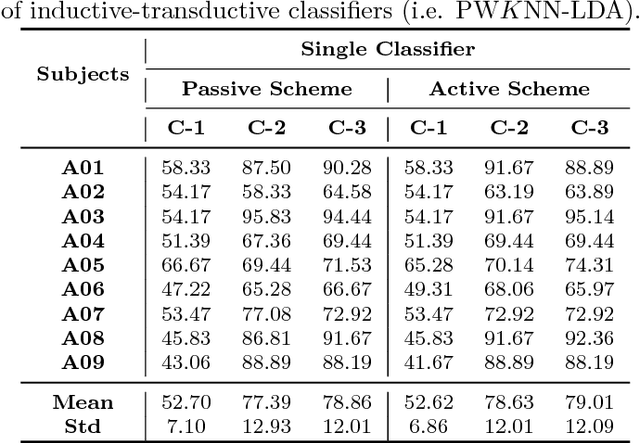
Abstract:The non-stationary nature of electroencephalography (EEG) signals makes an EEG-based brain-computer interface (BCI) a dynamic system, thus improving its performance is a challenging task. In addition, it is well-known that due to non-stationarity based covariate shifts, the input data distributions of EEG-based BCI systems change during inter- and intra-session transitions, which poses great difficulty for developments of online adaptive data-driven systems. Ensemble learning approaches have been used previously to tackle this challenge. However, passive scheme based implementation leads to poor efficiency while increasing high computational cost. This paper presents a novel integration of covariate shift estimation and unsupervised adaptive ensemble learning (CSE-UAEL) to tackle non-stationarity in motor-imagery (MI) related EEG classification. The proposed method first employs an exponentially weighted moving average model to detect the covariate shifts in the common spatial pattern features extracted from MI related brain responses. Then, a classifier ensemble was created and updated over time to account for changes in streaming input data distribution wherein new classifiers are added to the ensemble in accordance with estimated shifts. Furthermore, using two publicly available BCI-related EEG datasets, the proposed method was extensively compared with the state-of-the-art single-classifier based passive scheme, single-classifier based active scheme and ensemble based passive schemes. The experimental results show that the proposed active scheme based ensemble learning algorithm significantly enhances the BCI performance in MI classifications.
* 28 Pages, 3 figures, Neurocomputing
 Add to Chrome
Add to Chrome Add to Firefox
Add to Firefox Add to Edge
Add to Edge